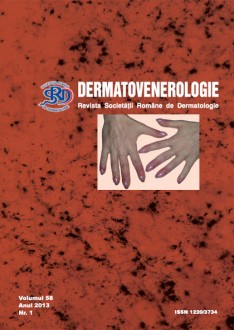Studii clinice si experimentale
Studiul concordantei scorurilor Pasi si Dlqi la bolnavii cu psoriazis vulgar: 104 cazuri
Introducere.
In ultimul timp, s-a acordat o atentie deosebita efectelor psihologice ale diferitelor afectiuni cutanate, inclusiv psoriazisul, si influenta acestora asupra calitatii vietii pacientilor.
Am efectuat un studiu retrospectiv pe un lot de 104 pacienti cu psoriazis vulgar.
Obiectiv
Aprecierea gravitatii psoriazisului folosind scorurile PASI si DLQI si evaluarea concordantei intre cele doua scoruri.
Bolnavi si metoda
Lotul de studiu a fost format din 104 pacienti diagnosticati cu psoriazis vulgar si spitalizati in Clinica Dermatologie Craiova in anul 2012. Aprecierea severitatii bolii de catre medic s-a facut pe baza scorului PASI, iar pentru cunoasterea efectului psoriazisului asupra calitatii vietii am apelat la chestionarul standard, cu calcularea scorului DLQI. Am prelucrat statistic datele apeland la programul SPSS 17.0, coeficientul statistic Spearman si la testele non- parametrice Mann-Whitney U.
Rezultate
Lotul nostru a cuprins 55 femei si 49 barbati. Proveneau din mediul urban 61 %. Bolnavii aveau varste cuprinse intre 14-80 ani, cu o varsta medie de 53,04 ani. Media pentru scorul PASI 7,58 (minim 0,8, maxim 49) iar pentru DLQI a fost 11,10 (minim 1, maxim 30). Cu
ajutorul coeficientului Spearman noi am constatat o corelatie puternica intre PASI si DLQI ( rs=0,533; p=0,001). Am remarcat, de asemenea, o importanta corelatie din punct de vedere statistic intre DLQI si afectarea psihica a pacientilor cu psoriazis extins (p<0,002).
Nu am gasit corelatii semnificative statistic intre DLQI si mediul de provenienta, varsta sau sexul pacientilor.
Analiza comparativa a celor doua scoruri a relevat, totusi, discordanta intre PASI si DLQI la 14 cazuri. La 13 bolnavi DLQI a avut valori mari (> 10), in timp ce PASI a fost cuprins in intervalul 0,8- 5,8. Dintre cei 13 bolnavi, 10 prezentau leziuni de psoriazis pe regiunile expuse privirii (maini, facies, scalp, regiunea cervicala).
Concluzii
Se confirma faptul ca localizarile psoriazisului la nivelul mainilor, faciesului si scalpului,
desi mai reduse ca intindere, sunt mai stigmatizante pentru pacient, avand impact important sau foarte important asupra calitatii vietii acestuia. Discordanta intre DLQI (valori mari) si PASI (valori mici) este mai frecventa la sexul feminin si in mediul urban. Consideram aceasta discordanta ca fiind secundara gradului diferit de perceptie a bolii de catre femei si barbati si consecinta unor relatii socio-profesionale mai complexe in urban.


